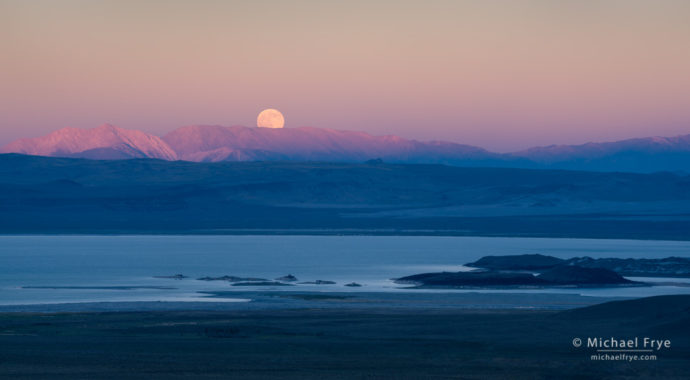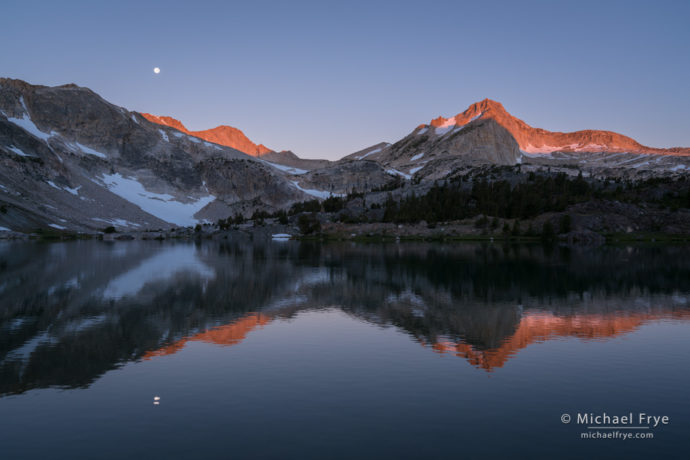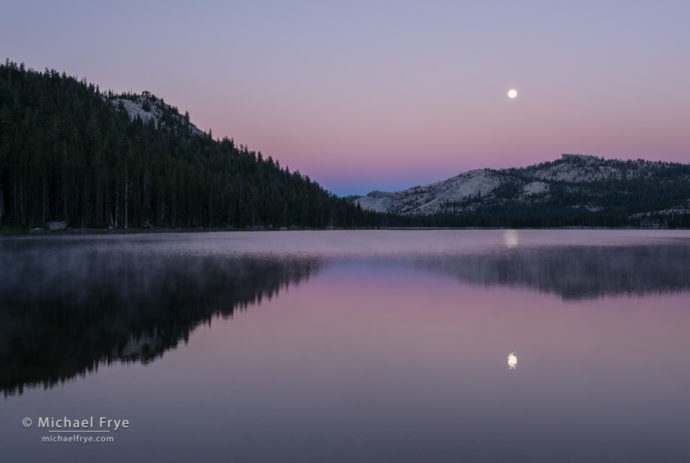In this previous post I wrote about some of the common misconceptions about photographing the full moon. For example, many people assume that full-moon photographs are taken at night, but in fact most are taken at sunrise or sunset when the light of the moon and landscape are in balance. And it’s often better to take these photographs on the days before or after the actual full moon, not when the calendar says “full moon.” That post helps explain some of the gyrations of the sun and moon so you can understand the best times to photograph the moon above a landscape. There are also some excellent apps that can help you pin down precisely where and when the moon will rise and set. The best of these are PhotoPills and The Photographer’s Ephemeris, and I used both to figure out where and when to take our group during the workshop.
The photograph above was actually taken on the date of the full moon, but that only worked because we had a high vantage point where the moon would rise above the distant mountains before the sun had completely set. The exposure for that scene was relatively easy, because the moon and the mountains were both lit by the sun as the moon was rising and the sun was setting behind us. The exposure was also relatively easy for the photograph of Mt. Conness and North Peak below, because again both the mountains and moon were lit by the sun (this time at sunrise as the moon was setting). The exposure for the image of Teneya Lake below was a bit more difficult, because it was taken a little before sunrise, with that pink, pre-dawn glow in the sky to the west. In that case the moon was much brighter than the landscape, so I bracketed exposures and used Lightroom’s HDR Merge to get detail in both the moon and the mountains.
Although exposures for moonrise and moonset scenes can be challenging, they’re not that difficult, and the software tools for processing high-contrast scenes have gotten much better. And apps like PhotoPills and The Photographer’s Ephemeris have made it much easier to plan when and where to photograph these events. There’s a bit of a learning curve with these apps, but their websites have excellent tutorials, and the payoff is worth the effort. The moon can add a sense of mystery and timelessness to a landscape, and elevate an otherwise ordinary scene into something special.
— Michael Frye
Related Posts: Moonstruck; Moon Above Half Dome
Michael Frye is a professional photographer specializing in landscapes and nature. He is the author or principal photographer of The Photographer’s Guide to Yosemite, Yosemite Meditations, Yosemite Meditations for Women, Yosemite Meditations for Adventurers, and Digital Landscape Photography: In the Footsteps of Ansel Adams and the Great Masters. He has also written three eBooks: Light & Land: Landscapes in the Digital Darkroom, Exposure for Outdoor Photography, and Landscapes in Lightroom: The Essential Step-by-Step Guide. Michael has written numerous magazine articles on the art and technique of photography, and his images have been published in over thirty countries around the world. Michael has lived either in or near Yosemite National Park since 1983, currently residing just outside the park in Mariposa, California.












Michael, what is the white spot in the water close to the shore that appears to be a second reflection of the moon. If so, how does that happen? I noticed it because recently while in Antarctica I had the experience of photographing a moonrise and got a second “moon” when I was using my iPhone. When I took the same shot with my Fuji X-T1 camera I got no second moon, and I have assumed it was somehow a reflection off the iPhone waterproof case. I’m sure yours has a very different explanation, but I cant figure it out. Thanks, Carol
It is in the area of NO reflection, so it must be a lens flare or some lens-related aberration. Good eye and good question, Carol. Beautiful shots, Michael.
Carol, Don, that’s not lens flare or some aberration. Have you ever looked at the moon or sun reflected in the water when the water is ruffled? It turns into a long, vertical, wavy streak, like this:
https://www.michaelfrye.com/portfolios/yosemite/#!prettyPhoto[1]/https://www.michaelfrye.com/wp-content/uploads/2015/07/20262.jpg
I suppose it does that because the ripples in the water reflect the sun or moon at different angles. In any case, in the photograph here of Tenaya Lake the water in the distance is ruffled, as you can see, so you’re seeing part of that long, vertical streak. Lower down the water is calmer, so the streak ends and you just see the more-or-less round reflection of the moon.
Michael, after I sent my comment and query I realized that it did look like a reflection in the ruffled water. I guess I have never seen it in a mixture of ruffled and then smooth water. Honestly, I did know that it would not have been an artifact in a photo of yours! Thanks for the explanation.
You’re welcome Carol – glad that helped to clarify things.
Michael,
Great photos! Wish I was there! Can’t wait until January!
Cheers,
Alyn
Thanks Alyn!
Thanks, Michael, as always very helpful. Lovely photos in your post. Much appreciated.
Thank you Robert!
Beautiful photo
Thanks Patsy!